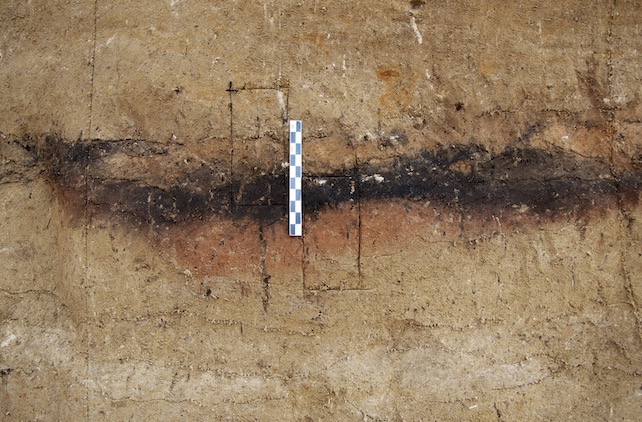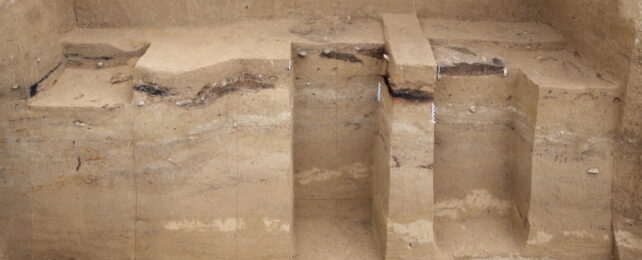Learning to control fire was a game-changer for ancient humans, who could use it to cook food, see at night, and endure cold weather, among other things.
This skill dates back at least a million years, and while fire has proven pivotal throughout human history, it can be especially valuable at certain times.
The Last Glacial Maximum (LGM), for example, was the iciest part of the most recent glacial period in Earth's current ice age – and presumably a great time to cozy up by a fire.
Yet despite the era's extreme cold, there is scant evidence of humans using fire during the LGM, which lasted from about 26,500 to 19,000 years ago.
In a new study, researchers sought answers to this mystery by analyzing the remains of three ancient fireplaces found at an archaeological site in modern-day Ukraine, all of which are associated with human occupations at the site during the LGM.
These hearths reveal new details about pyrotechnology in the late Upper Paleolithic – a span of several frigid millennia when fireplaces seem inexplicably rare in the archaeological record.
"We know that fire was widespread before and after this period, but there is little evidence from the height of the Ice Age," says co-author William Murphree, a geoarchaeologist at the University of Algarve in Portugal.
Previous research suggests fire loomed large in the lives of Upper Paleolithic people, enabling vital activities that would be difficult or impossible without it.
"Fire was not just about keeping warm; it was also essential for cooking, making tools, and for social gatherings," says co-author Philip Nigst, an archaeologist at the University of Vienna in Austria.
The LGM brought "rapid climatic deterioration" to Europe, the researchers note, with extremely cold, arid conditions that led to habitat loss and geographic isolation. In that context, it seems unlikely people would choose to build fewer fires.
Maybe the cold hindered tree growth in steppes and grasslands, limiting the supply of firewood. Or maybe people built as many fires as ever, but harsh conditions during and after the LGM destroyed most of the evidence.
This prehistoric trend may also be an illusion, reflecting a modern publication bias more than an actual decline.
Given this uncertainty, the discovery of multiple hearths from the LGM could be revelatory. In addition to insights about ancient fire traditions, it might offer clues about the apparent dearth of hearths from this era.
Researchers investigated three hearths previously uncovered at Korman' 9, a site on the Dniester River in Ukraine. They analyzed each with a series of geoarchaeological techniques, seeking long-lost details about fires built tens of thousands of years ago.

Using microstratigraphic, micromorphological, and colorimetric analyses, they found the remains came from flat, open fireplaces, and that people mostly burned wood in them.
Despite their simplicity, these fires could have heated the ground to 600 degrees Celsius, which could indicate a fire burning well over that temperature, suggesting impressive pyrotechnic sophistication, especially amid such climatic upheaval.
The lack of big charcoal fragments made it hard to identify the main fuel source, but analysis of available charcoal revealed a predominance of spruce wood.
The hearths also contained traces of bone, but it's unclear why, explains co-author Marjolein Bosch, a zooarchaeologist at the University of Vienna, the Austrian Academy of Sciences, and the Natural History Museum Vienna.
"Some of the animal bones found at the site were burnt in a fire with a temperature of over 650 degrees Celsius. We are currently investigating whether they were used as fuel or just accidentally burned," Bosch says.
Differences among the three hearths could point to separate occupations of the site, possibly weeks or centuries apart, or these could be specialized hearths used by people within one occupation for various purposes or seasons.
"People perfectly controlled the fire and knew how to use it in different ways, depending on the purpose of the fire," Nigst says. "But our results also show that these hunter-gatherers used the same place at different times of the year during their annual migrations."
While at least some people apparently retained their pyrotechnic skills during the LGM, more research is still needed to explain why we find so few hearths like these at contemporary sites.
"Was most of the evidence destroyed by the ice-age-typical, alternating freezing and thawing of the soil?" Murphree says.
"Or did people not find enough fuel during the Last Glacial Maximum?" Nigst adds. "Did they not use fire, but instead relied on other technological solutions?"
The study was published in Geoarchaeology.
